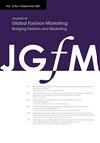可持续性供应商记分卡评估工具:服装零售商之间的比较
IF 5.5
Q2 BUSINESS
引用次数: 2
摘要
摘要本定性研究的目的是评估和比较沃尔玛、艾琳·费舍尔、耐克、H&M和Gap五大国际服装零售商使用的八种可持续发展供应商记分卡评估工具。归纳内容分析用于研究原始文本数据并进行循证推理。结果表明,可持续供应链管理领域存在效率低下的问题,因为报告信息的标准不充分,这会暴露出这些效率低下的情况。所调查的工具在范围、绩效衡量和评分方法方面各不相同,这对其可比性产生了负面影响。然而,这一障碍并没有使主要调查结果无效,这些调查结果表明,明显缺乏支持所调查工具实际应用的信息,令人担忧。由于没有零售商披露其低级别供应商评估的信息,因此不确定低级别供应商是否以及如何参与可持续性评估。由于在分散的供应链中,违反可持续性的行为发生率更高,因此在整个价值链中传达供应商参与度至关重要。这项研究的结果敦促应用标准化和全面的记分卡评估,这将有助于提高SSCM实践、评估和沟通的可信度。本文章由计算机程序翻译,如有差异,请以英文原文为准。
Sustainability supplier scorecard assessment tools: A comparison between apparel retailers
ABSTRACT The purpose of this qualitative study is to evaluate and compare eight sustainability supplier scorecard assessment tools in use among five major international apparel retailers, Walmart, Eileen Fisher, Nike, H&M, and Gap. Inductive content analysis was used to study the raw textual data and make evidence-based inferences. Results showed that the field of sustainable supply chain management (SSCM) is subject to inefficiencies because there are inadequate standards for reporting information which would expose these inefficiencies. The investigated tools varied in terms of scope, performance measurements, and scoring methodologies, which had negative effects on their comparability. This obstacle, however, does not invalidate the major findings, which revealed an evident and concerning lack of information to support the practical application of the tools investigated. Because no retailer disclosed information about its lower tier suppliers’ assessments, it is uncertain whether and how suppliers in lower tiers are engaged in sustainability assessments. Because sustainability violations occur at a higher rate within fragmented supply chains, it is critical to communicate supplier engagement throughout the value chain. The findings of this study urge the application of standardized and comprehensive scorecard assessments which would help to enhance the credibility of SSCM practice, its assessment, and its communication.
求助全文
通过发布文献求助,成功后即可免费获取论文全文。
去求助
来源期刊

Journal of Global Fashion Marketing
BUSINESS-
CiteScore
6.90
自引率
31.60%
发文量
34
期刊介绍:
The Journal of Global Fashion Marketing is a quarterly journal that publishes peer-reviewed conceptual and empirical papers and business cases of original works that significantly contribute to the overall advancement of marketing theory, research, and practice in fashion, design, and culture. JGFM endeavors to be a “global bridge” connecting marketing scholars and practitioners in fashion, design, and culture throughout the world. We publish high-quality scholarly articles on marketing written by contributors representing the leading academic authors. As we state on the cover of every issue, our positioning statement, our value added to the marketing scholar readership, is truly to “Bridge Fashion and Marketing” 1. Monitor and analyze global fashion marketing trends. 2. Generate and integrate new ideas and theories related to fashion, luxury, and culture marketing theory and practice. 3. Apply new research methods and techniques in fashion, luxury, and culture marketing. 4. Explore and disseminate cutting edge fashion marketing practices. JGFM welcomes manuscripts that provide fresh, innovative insight to any topic in the field of fashion, luxury, and culture marketing. Both conceptual and empirical works are valued, so long as the manuscript addresses substantive issues in marketing.
 求助内容:
求助内容: 应助结果提醒方式:
应助结果提醒方式:


